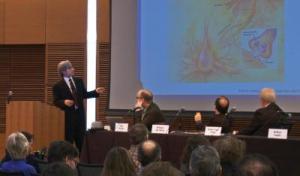By Molly Simis
Arthur Lupia, political science professor at the University of Michigan, kicked off the Science Writing in the Age of Denial conference with a presentation about trying to avoid conflict with diverse audiences.
The oft-adopted, knowledge-deficit model of communication — “If we tell them what we know, they will change how they think and what they do” — doesn’t work, according to Lupia. Neither do a lot of other attempts, but for different reasons:
“In attempts to educate the public and policymakers about science, failure is common,” he said. “Failure meaning the impact you want the presentation to have and the reality of what your audience perceives.”The problem is not “them,” Lupia said. The problem is “us.” Blaming the audience for not receiving the message we intended “absolves us of the responsibilities of having to think about our strategies.”
In order to illustrate the perils of not knowing the audience’s starting point, Lupia invited the audience to take a walk in the woods:
Imagine that you grew up near the woods, and throughout your life developed an intimate relationship with the woods — so intimate that you can journey through it expertly. One day you’re walking with your friend, and you get separated from each other. Since you know the woods so well, you get out because you are an expert in navigating through these trees. Your friend, however, is stuck in these woods, and to get your friend out, you have to know two things: 1) the woods and 2) where your friend is in the woods. If you say to your friend “take three steps to your left” without knowing where your friend is, you might be advising your friend to walk directly into a tree.
Instead of fruitlessly trying to get the audience out of the figurative woods, communicators can turn to biology as a starting place of understanding where the audience is. Lupia explained that “biology defines the possibilities” of how people make decisions and are persuaded.
Persuasion, Lupia emphasized, is a “change in mind, not just metaphorically, but also physically.” As learning occurs, brain cells, fueled by electrochemical processes, move closer to other cells, creating associations. The physical basis of associations between, for example, the word wagon and the color red, is physical relationships between brain cells. “Ultimately, if you want people to think, you’re trying to grow new memories. If you can’t do that, then it’s game over.”
To grow new memories, communicators face a few battles: a battle for attention, a battle for elaboration, and a battle for credibility. The audience is not going to hang on the every word, and no one is an exception to that rule. Working memory has an impressively fast decay rate for most stimuli. To overcome distractions and short attention spans, a communicator must make the message urgent and relevant to the audience, and then seize the “opportunity to leave a cognitive legacy.” This requires inducing changes relevant to activation potentials and in, ultimately, long-term memory. Changes in long-term memory require elaboration.
People only remember a fraction of any event, even when remembering life-defining moments. People aren’t interested in objective information; they engage in motivated reasoning. In other words, Lupia said, “people have a tendency to seek out and/or view new evidence as consistent with one’s prior views, even if it’s not objectively sound.” To effectively fight the battle for elaboration, Lupia advises, communicators need to make the message close, concrete and immediate, and achievable.
None of this matters, though, if the communicator is not seen as credible.
Credibility is bestowed by audiences, is specific to each domain, and — most importantly — is not objectively about the communicator. It’s about how the audience perceives the communicator. Credibility is a function of source, message and contextual attributes, as well as audience effects. To establish credibility with a nonscientific audience, communicators have to move away from making presentations that affirm their own values (and from blaming the audience if it does not persuade) toward understanding different perspectives of different audiences.
“We can understand them, and if we do we can take our conversations to great places by understanding why they do what they do,” Lupia said.
The panel, including John Hawks, science blogger and University of Wisconsin-Madison paleoanthropology professor, Wilson da Silva, editor and founder of Cosmos magazine, and Robert Lee Hotz, science columnist at the Wall Street Journal. Follow up included a discussion of the nature of uncertainty, the golden age of science (“Which we’re in,” according to Hotz), and the trustworthiness of science itself.
Molly Simis is a student at the University of Wisconsin-Madison. Video of Lupia's session can be viewed at the conference web site




